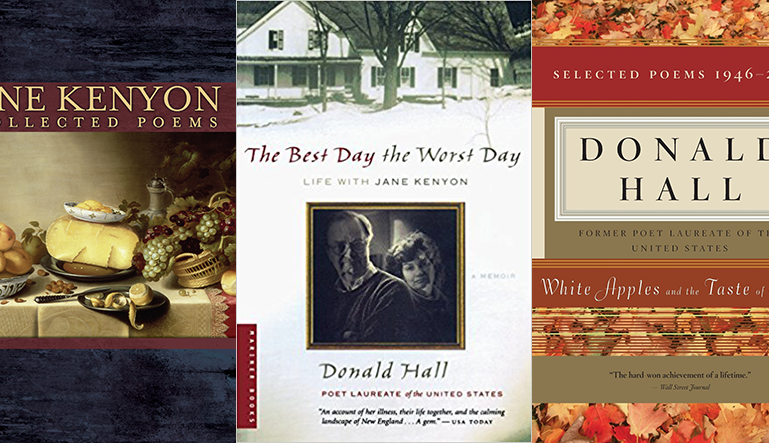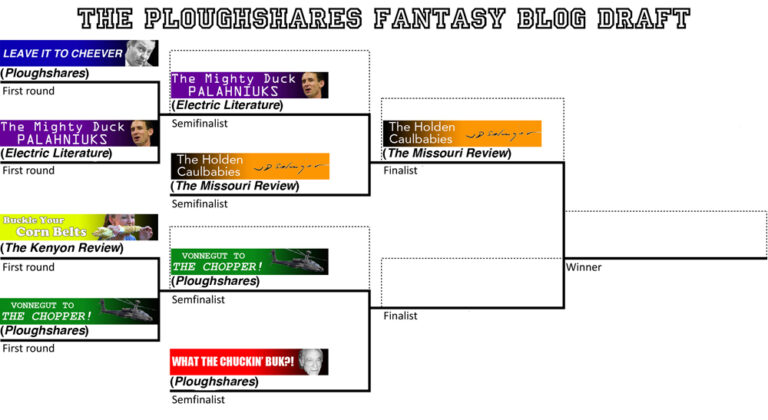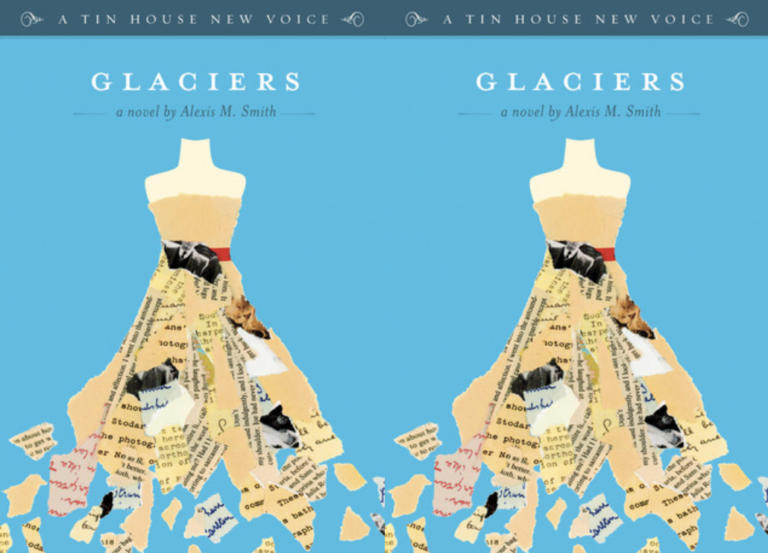
Guest post by Megan Mayhew Bergman
Donald Hall is a thing of beauty. I’ve had the pleasure of hearing him speak–seeing him speak–twice at Bennington. The second was in June 2009–six weeks after my first child was born, a week after attending my beloved mother-in-law, Anna’s, memorial service, and days after leaving my family in North Carolina to settle in Vermont with my husband in the house where he grew up.
Donald Hall was wearing a rumpled tie-dyed t-shirt and trousers. His hair was long and his beard curled over, and at times into, his mouth, giving him the otherworldly look of Confederate veterans I’d seen in vintage photographs, or an elderly Walt Whitman. His lips made oblong shapes when he spoke about prosody. His voice moved between a whisper, a growl, and a specter-like song, pausing at invisible line breaks. His casual posture gave you the feeling he was in the mood to be recklessly, charmingly honest about meter, Robert Frost, and baseball.
You want to know what really turns me on? Hall said. Assonance. Assonance turns me on.
It was the first time I’d laughed in weeks, in a time when I’d forgotten I was capable of laughing. I was still fat and achy, a post-partum mess of grief and haywire hormones. I was attending my graduate residency at Bennington College, but painfully aware of the grieving family, unpacked boxes and colicky infant that waited for me back home, a few miles down the road.
Years earlier I’d leafed through Hall’s memoir of life with Jane Kenyon, The Best Day, the Worst Day, in a bookstore. Seeing him again, I knew I had to return to it. That night, I tore through boxes of books, searching for Jane Kenyon’s Collected Poems, and brought it to bed. I ordered Hall’s memoir and purchased White Apples and the Taste of Stone from the Bennington bookstore. The convergence of events in my life, and events Kenyon and Hall had written about so beautifully, was clear–namely Jane’s move to her husband’s ancestral home, Eagle Pond Farm, her bout with cancer, and Hall’s grieving process after her death in 1995.
I’d come to approach nighttime with a sense of dread. My daughter wasn’t yet sleeping through the night, and getting her to fall asleep for the evening usually entailed a few laps around our thirteen acres at dusk. I’d feed and swaddle her, and she’d wail and fuss with colicky vigor. I’d bounce, sing, and kiss her cheeks, walking barefoot in the grass, missing my own mother who was now a twelve-hour drive south. Once my daughter was asleep, I’d immediately head for my own bed, where exhausted, I’d make it through a few pages of Hall and Kenyon, and fade.
The first weeks after the Bennington residency were a survival game. The well-intentioned questions about how we were dealing with Anna’s death and how I was faring as a new mom far away from my family were painful to answer; I flinched whenever someone tried to draw me into a serious conversation. In The Best Day, the Worst Day, Hall confesses, “I took the phone off the hook. I could not bear the notion of someone calling to ask how we were doing.” Avoidance, it seemed, was a common coping mechanism.
Though months wore on, I felt myself processing Anna’s absence on a delayed schedule. Her presence was still strong in the house; a motorcycle-riding veterinarian at the top of her career, she’d been an irreplaceable, multi-tasking life force. But physically and emotionally, I was focused on my new daughter. The birth-death continuum was too profound, the stress of major life events too real to digest real time. On top of it all, I felt alien in my new home, plugged into someone else’s life.
How does one accept death? I asked myself. What were other members of my family feeling? How could I help? What would life be like, living in a house that would always be more my husband’s than mine? I didn’t have the answers, and wouldn’t. But through Kenyon and Hall, I felt myself opening up to beautifully rendered notions of grief and loss, and perhaps some modicum of understanding of my new life in rural Vermont.
For example, after Jane’s passing, Hall knew the habit I’d acquired of counting days since my mother-in-law’s death, making strange anniversaries, as seen in “Midsummer Letter”:
The polished black granite
Cemented over your head
Reflects the full moon of August
Four months from the day
Your chest went still.
…and again in “Secrets”:
It is half a year since we slept beside each other all night.
I wake hollow as a thighbone with its marrow picked out.
In Letter in Autumn, Hall writes of cleaning out Jane’s Saab, finding her hair ties, and not wanting to disturb her possessions:
I cannot discard
your jeans or lotions or T-shirts.
I cannot disturb your tumbles
of scarves and floppy hats.
Hall describes the muséal quality a house and its contents take on after a death, the intense reverence for possessions. I too was living among someone else’s things, scared to alter the environment as my mother-in-law had left it. Her jackets were still in the closet, her writing on the chalkboard.
In “Letter at Christmas,” Hall attaches memories to a pair of loafers Jane ordered him from LL Bean, the “spidery lace of a shawl” he’d given her. “Melancholy still thickens / its filaments over the presents / I gave you that morning,” he writes. In “Sweater” he roves the tool shed and Jane’s desk for clothes to give a secondhand store; in “Throwing the Things Away” he undergoes the brutal decision process of what to keep. I nodded along with his lines; to me, things were no longer just things–everyday objects had become loaded with meaning. One night we dropped the bowl Anna had used to make her Sunday standard, banana walnut pancakes–the sound of shattered pottery was a brutal exclamation point.
Hall details surreal moments of forgetting Jane is actually gone. In “Letter in Autumn” he writes, “Today when the telephone rang / I thought it was you.” In “Letter at Christmas” he writes, “Yesterday I caught sight of you / in the Kearsarge Mini-Mart.” As months wore on, I found myself composing emails to Anna, making mental notes of things I’d tell her when we next spoke. Her number was still programmed into my cell phone; I used to send her pictures of my pregnant belly to make her laugh during those last painful months.
This kind of grief was foreign to me; I’d never felt this way. I didn’t know how to speak about it, or if I should speak about it at all. I felt transformed, as if the glut of new emotions–love for my child, exhaustion, grief, homesickness–had made me an entirely different person. Hall, however, was able to put words to the way death recalibrates perspective:
Let us stifle under mud at the pond’s edge
and affirm that it is fitting
and delicious to lose everything.
The “deliciousness” Hall speaks of–I understood it. The pain was a gift, a reminder, and coupled with the birth of my daughter, the realest thing I’d ever known. Despite the sleep deprivation, I felt awake–excruciatingly awake–for the first time in years.
Fast forward. A year later, the ardent daily act of grieving became blunt pain–a smarting handprint after a cosmic slap–and I began to think seriously about what it meant to live in my husband’s childhood home. I turned to Jane, who’d moved to Eagle Pond Farm with Hall in 1975, and began to occupy the bedroom his grandmother had been born in–in 1878.
Kenyon’s Collected Poems was put on my reading list during my first semester at Bennington College’s MFA program. Her poem “Let Evening Come” was read at my mother-in-law’s funeral. Yet it was her earlier work I was fascinated by, her musings on rural New England and making her life in a place where her husband’s connection was, initially at least, stronger than her own.
The first section of poems, Under a Blue Mountain, lead me to what I can only describe as a feeling of deep kinship with Kenyon. In “From Room to Room” she writes of getting to know a house, noting:
I am clumsy here, thrusting
slabs of maple into the stove.
Out of my body for a while,
weightless in space.
I, too, was clumsy in my new rural life, forgetting to dump the compost, spilling feed as the goats jostled me at dinnertime. At first I didn’t know how to cook with beets, or what to do with five-pound zucchinis. The 1834 farmhouse was drafty and full of clothes and furniture that didn’t belong to me; I was afraid to childproof anything. The coyote yodels that bounced off the mountains at night gave me chills. When the fire went out in the woodstove in winter, I was unable to relight it–I smoked up the kitchen like bad slapstick comedy. My life was in boxes; I forgot what I owned. How will I ever make my mark on this life? I wondered. Can I be happy here?
In her poem “Here,” Kenyon writes, presumably to Hall:
You always belonged here.
You were theirs, certain as a rock.
I’m the one who worries
if I fit in with the furniture
and the landscape.
Amen! I thought, surrounded by antiques and family photos. But as the poem progresses, Kenyon seems to take a step forward in making peace with her new life, knowing perhaps a greater happiness lies ahead. After realizing the “curves in the road are familiar” and upon seeing her new house from a distance, she muses:
I feel my life start up again,
like a cutting when it grows
the first pale and tentative
root hair in a glass of water.
In “Two Days Alone,” Jane spends time in the house on her own, and concludes: “Maybe / I don’t belong here. / Nothing tells me that I don’t.” It’s as if the root hair she speaks of in “Here” has begun to spread–tentatively–and has found solid ground. Eventually, I too began to feel more at home; I developed my own routines. I went to the Shaftsbury Country Store for coffee each morning, found new hikes, painted our bedroom gray-blue, endeared myself to the goats, learned how to run on packed snow.
But it’s Kenyon’s poem “Finding a Long Gray Hair” that moves me most. While scrubbing the kitchen floorboards, Jane realizes she is “repeating / the motions of other women / who have lived in this house.” She writes:
And when I find a long gray hair
floating in the pail,
I feel my life added to theirs.
As Jane discovered, chores become an act of communion in an old house. Now, I feel most connected to Anna when I feed the barn, muck the stalls, weed the garden, make ratatouille, or freeze zucchinis. I like the notion of my existence here as an “addition”; I try to look at my new life that way, a building exercise. We’ve added three dogs, a cat, and five chickens to the farm menagerie. Our garden layout is different this summer; we’re trying pumpkins and sweet potatoes to soothe my eastern North Carolina soul. But I find I’m still eager for my mother-in-law’s approval–would she like the additions we’ve made?
We’re embracing this life, moving forward, thankful for the wide-open fields our newly bipedal daughter runs through. We’re constantly planting, building, harvesting. It’s a physical life in a digital world, one we’re eager to introduce to our wide-eyed daughter. As Jane says in “The Clothes Pin”:
How much better it is
to carry wood to the fire
than to moan about your life.
Though the tower of books on my bedside table rotates weekly, Hall and Kenyon retain a permanent spot, at least for the foreseeable future. They speak too much truth; they’re too precious to shelve in a time when their words still resonate so much.
Your presence in this house
is almost as enormous
and painful as your absence. (Hall, “Letter with No Address”)
And should I ever have the privilege of hearing Donald Hall speak again, I’ll go, and strain my ears to catch every word of his melodic growl. Funny–I’ll be a stranger to him; he won’t know how dear and useful he has been to me, the kind of good friend who says things better than I ever could.
This is Megan’s first post for Get Behind the Plough.


